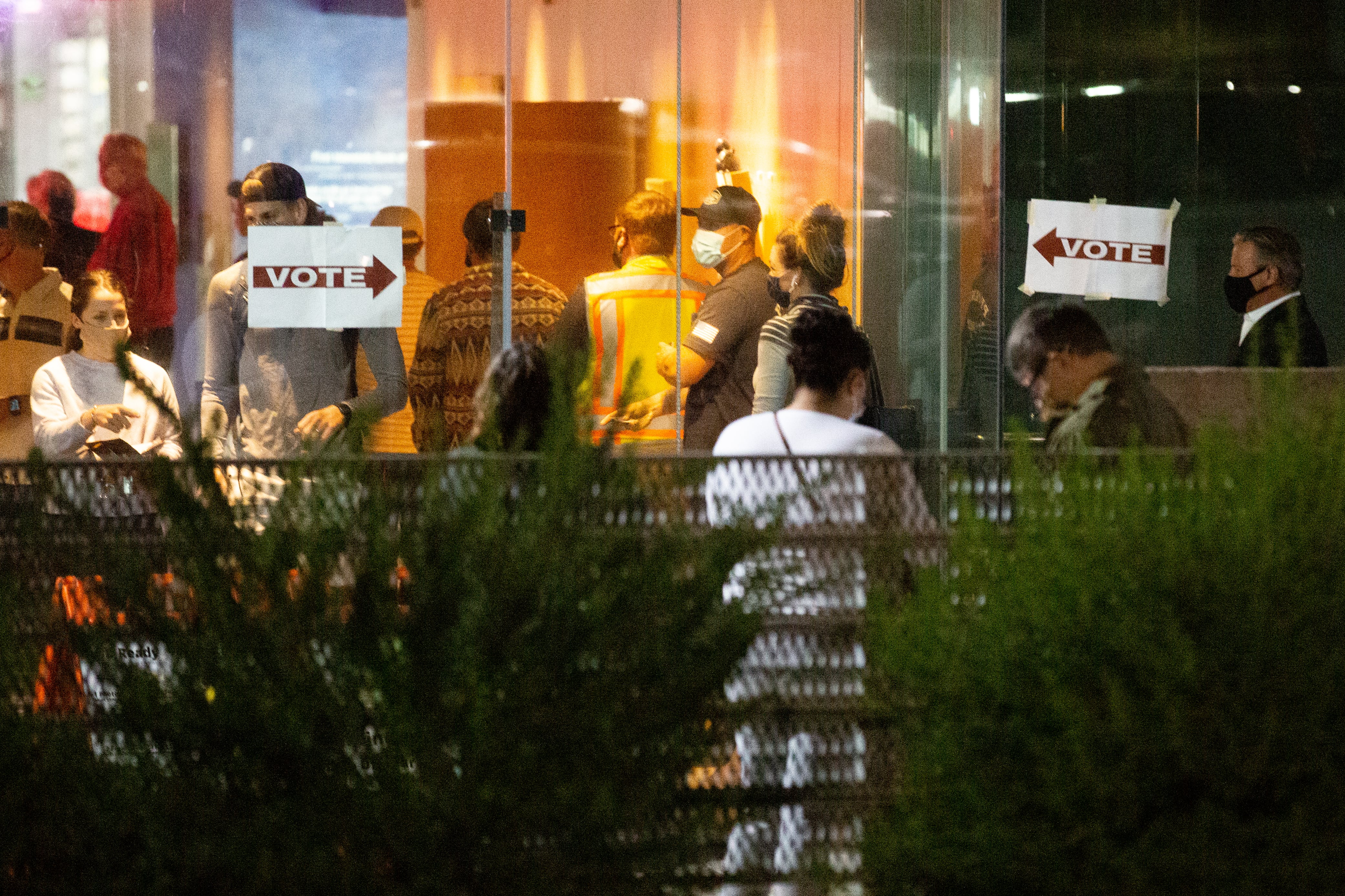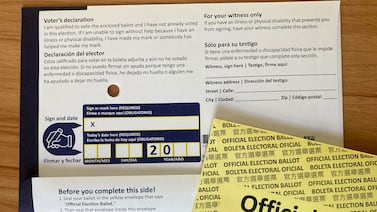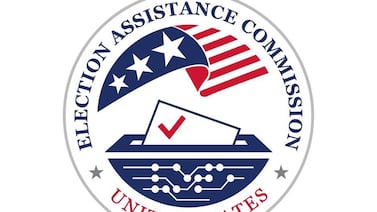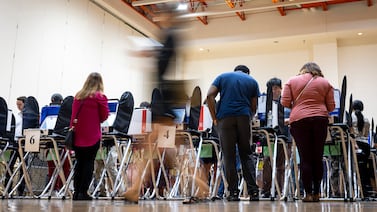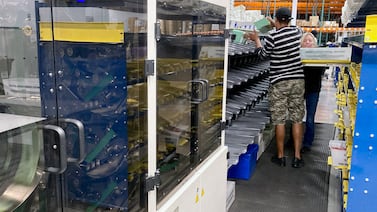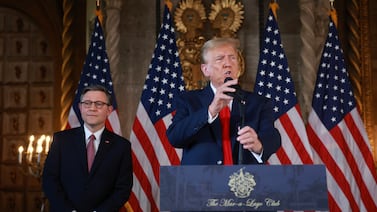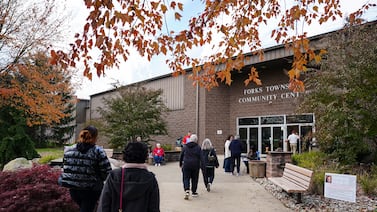Election officials in Arizona expect in-person voting to surge during the state’s August primary election, since fears of COVID-19 have somewhat dissipated and concerns over the security of voting by mail have increased.
Maricopa County, which includes Phoenix and nearly two-thirds of the state’s voters, is more than doubling the number of in-person voting locations for the Aug. 2 primary, opening 215 compared to 99 during the 2020 primary. Pima County, which includes Tucson, the state’s second-largest city, is also planning for more in-person voting.
States that have already held primary elections — such as Georgia, Indiana, Ohio, Indiana and West Virginia — saw upticks in in-person voting this year after changing their rules in 2020 to allow for more access to mail ballots.
To be sure, Arizona officials aren’t expecting a massive switch. That’s because the state has for decades allowed no-excuse early and mail voting, and for years the vast majority of voters here have cast ballots early and by mail. For the upcoming election, about 75% of voters in the state are on an early voter list ensuring they will automatically receive a mail ballot.
The county is expecting around 100,000 to 150,000 voters casting in-person ballots on Aug. 2, based on two separate predictive models, compared to about 50,000 on Election Day for the 2020 primary. For the general election, the county is also expecting roughly double the 2020 number. It plans to have 225 locations, up from 175 in November 2020.
Maricopa is predicting a commensurate drop in early voting numbers, including in-person early voting and voting by mail. In both the primary and general election in 2020, more than 90% of voters cast ballots early. Two main factors are shaping Maricopa County’s predictions, according to the 2022 election plan approved by county supervisors. The first is taking into consideration that the reluctance to vote in-person during the height of the pandemic has ebbed.
The second, according to the election plan, is the “significant amount of mis-, dis- and mal-information spread about the security of voting processes, especially as it relates to voting by mail” since the 2020 election. That’s what could push some voters who have traditionally voted early to instead vote on Election Day.
Meanwhile, some Arizona lawmakers continue to spread former President Donald Trump’s false rhetoric about the risks of voting by mail, along with new misinformation alleging fraud at ballot drop boxes.
Officials from across the state say they are using data from 2018 and other past elections, not 2020, to predict how many people will come to the polls in person this year.
“2020 was really an anomaly,” said Scott Jarrett, a Maricopa County elections director.
The expected increase in in-person voters also means the county will need more than twice the number of poll workers it had in 2020. Recruiting them has been a challenge for some Arizona communities, in part because their regular workers feel the position has become too politicized and in part because of labor shortages.
“We are getting people signed up but we have to get through a lot of ‘no’s’ before we get one ‘yes,’” said Lynn Constabile, elections director in Yavapai County, a county northwest of Phoenix that includes Prescott.
Arizona Sticks to Vote Center Model as Lawmakers Call for Precinct Voting
One pandemic-related change that is sticking in Arizona this year: The ability for voters to cast their ballot at any location, instead of just at the polling place in their precinct.
Maricopa County switched to the so-called “vote center” model entirely in 2020, allowing it to cut the number of polling places it offered — from about 500 in the 2018 primary to about 99 in the 2020 primary — while giving voters more flexibility about where to go, and Pima County will try it out for the first time this year.
The increase in the number of vote centers this year will give Maricopa voters a shorter drive to the polls, Jarrett said, averaging about 1.3 miles from their homes, compared to two or three miles in 2020.
The county will be opening more vote centers for early voting as well, starting with 10 locations when early voting begins, 27 days before the election, and gradually increasing that number until Election Day.
The county, before and on Election Day, will have nearly triple the number of voter check-in stations as in 2020, which should help voters move through the process more quickly.
Maricopa County had reasonable wait times in 2020 — an average of two minutes, according to county data, and Jarrett said only 10 locations saw considerable wait times.
The increased number of locations and check-in stations are aimed at keeping it that way, given the expected increase in in-person voting. And as the county adds locations, it is addressing needs in places that did have longer wait times, such as Surprise and a few areas in the East Valley, Jarrett said.
At Surprise City Hall, wait times peaked to an hour at certain moments on Election Day in November 2020. The county is so far planning for six locations in Surprise for this year’s primary, compared to one in the 2020 primary. The county is also mailing information to voters about the closest vote center to them, which may help alleviate the long wait times at City Hall, according to county officials.
Voters will also return to more conventional polling places this year. In 2020, the county had to scramble to find locations large enough for social distancing measures, such as spreading out machines and people by six feet. That led to the county having to stop using some conventional, but smaller locations, for example Goodyear City Hall and Nadaburg School in Wittman, and instead rent out unconventional spaces such as closed storefronts.
That’s not something the county is doing this year, Jarrett said.
In Mohave County, which includes Kingman in northwestern Arizona, Elections Director Allen Tempert said he is planning to have around the same number of polling places as in 2018 and 2020. His county sets up at least one voting location per precinct on Election Day, and voters must vote within their precincts.
He is preparing for more people to show up in person than in prior years, but said he doesn’t expect a “180” back to in-person voting.
“I don’t believe that early voting is going to die off that quick,” Tempert said. He said Arizona has been doing “flawless” early voting since long before 2020.
Pima County Experiments with Vote Center Model
Pima County voters will be able to vote outside of their precinct on Election Day for the first time, since the county is switching to the vote center model.
This means the county will move from having about 279 precinct-based locations to 129 vote centers, said Constance Hargrove, who just started as the county’s elections director in April.
Hargrove said moving to vote centers allows the county to combine locations, which is more efficient and makes sense based on low turnout. At the same time, she said, it benefits voters who will now be able to vote near their work or wherever they may be in the county on Election Day.
Hargrove is also expecting to see a higher percentage vote in person in Pima County than in 2020.
Hargrove came from Virginia, where she was elections director in Chesterfield County, just south of Richmond. She said the in-person turnout increased dramatically in the county from 2020 to 2021, when Virginia held a gubernatorial election.
She said she thinks the easing of the pandemic, along with worries about mail voting, contributed to the increase there.
“We may see some of that in Maricopa County,” she said.
It’s an experimental year for Pima County, she said, as the county does its best to predict where vote centers are needed for the first time, as well as uses new technology to check-in voters and print ballots.
The vote center model is becoming more popular in Arizona and across the country at the same time some Republicans call for a move back to precinct-based voting, claiming that vote centers allow for fraud. For example, vote centers would have been banned under one Republican bill in Arizona.
It’s not the case that vote centers are insecure , Jarrett said during a May meeting with county supervisors. The technology used at vote centers — electronic poll books — actually makes verifying voter eligibility more accurate and efficient than using printed voter rolls, since the voter’s information is completely up to date.
That, along with ballot printers that can print any ballot style for any precinct, greatly reduce the number of provisional ballots and rejected ballots.
For example, previously, when a voter would show up to the wrong precinct in Maricopa County, they were given the option of casting a provisional ballot for that precinct if they believed they were in the right place. But if they were wrong, state law required that those ballots be rejected in their entirety, even if the voter was eligible to vote in some of the races. In 2016, that happened with about 3,000 ballots, according to county officials.
Ballot-on-demand printers at vote centers allow the voter to receive the correct ballot at any location, eliminating those rejected ballots.
Recruitment of Poll Workers
As counties prepare to see more in-person voters, they also face the struggle of hiring enough temporary workers to handle the demand at a time of record low unemployment and high inflation.
Maricopa County is aiming to hire about 2,600 poll workers for the primary election, up from about 1,000 in 2020. For the 2018 primary election, the county had around 2,500 poll workers.
In early May, the county was struggling to find and hire recruiters to help them fill the temporary positions. Jarrett told the Board of Supervisors at the May 2 meeting that they had posted eight recruiter jobs and only had one qualified candidate.
The board agreed at that meeting to increase pay for all temporary election worker positions, including the recruiters, who are now being paid $18 an hour instead of $15 an hour. Poll workers will be paid between $13 to $15 an hour.
The county has just a little over a month before the first early voting locations open on July 6, and has so far filled about 75% of the positions at the 10 locations that will open that day.


